Physical Address
304 North Cardinal St.
Dorchester Center, MA 02124
An ETT usually appears as a faintly radiopaque tube with a thin, densely radiopaque line along its length, and its position should be determined relative to the carina, which if not seen on a chest radiograph can be approximated by following the course of the mainstem bronchi medially at the T5-T7 level. In adults, the tip of an ETT should be below the thoracic inlet and approximately 5 to 7 cm above the carina when the patient's head is in neutral position, as flexion or extension of the neck can cause the tube to move either 2 cm higher or lower, respectively. The optimal width of the tube should be one half to two thirds of the tracheal width (generally <3 cm), and the inflated cuff should not distend the trachea because tracheal injury may occur.
If an ETT is inserted beyond the carina (i.e., with unilateral bronchial intubation), preferential hyperaeration and potential barotrauma of the intubated lung (more commonly the right) and hypoaeration and atelectasis of the contralateral lung may occur ( Figure 22-1 ). If the tube is not advanced far enough, inadvertent extubation or possible vocal cord damage caused by the inflated cuff may occur. Esophageal intubation is another potential complication, which can be detected clinically by gurgling sounds and distention of the stomach as air is insufflated and radiographically by lateral extension of the tube margins beyond the tracheal margins, visualization of the tracheal air column to the side of the tube, gastric distention, and lung hypoinflation. Other complications of ETT placement include:
Pharyngeal, laryngeal, or tracheobronchial injury (particularly if placed too high or if the cuff is overinflated).
Aspiration.
Sinusitis.
Dislodgment of teeth or dental appliances.
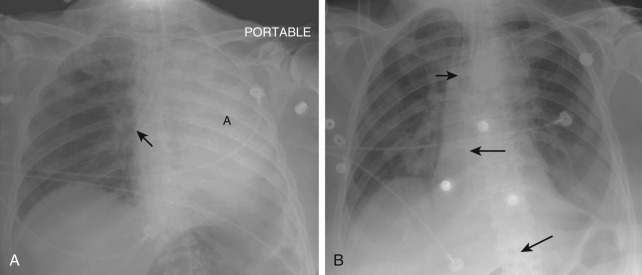
A tracheostomy tube tip is optimally located one half to two thirds of the distance from the stoma to the carina. The tube itself should overlie the trachea, and the width of the tube should be about two thirds of the tracheal width.
Injury of the recurrent laryngeal nerve with resultant vocal cord paralysis.
Injury of the lung apex with development of pneumothorax or pneumomediastinum.
Injury of the trachea with development of tracheomalacia or stricture.
Soft tissue infection, leading to tracheal ulceration and perforation with tracheal–innominate artery fistula, tracheoesophageal fistula, or cervical abscess formation.
An NGT or OGT usually appears as a faintly radiopaque tube with a thin, densely radiopaque line along the entire length of the tube ( Figure 22-2 ). Unlike an ETT, the thin, densely radiopaque line is interrupted near the distal tip of the NGT/OGT, representing a distal side hole. The tube should course inferiorly along the midline of the chest, with its tip located at least 10 cm within the stomach so that the distal side hole is situated in the stomach rather than in the esophagus.
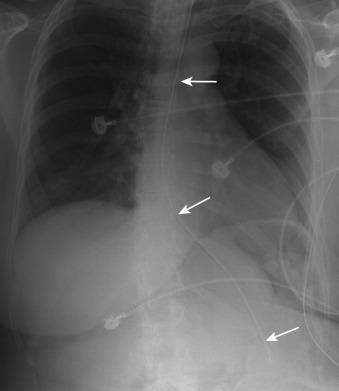
An enteral feeding tube usually appears as a faintly radiopaque tube, though without a thin, densely radiopaque line along its length (seen with ETTs, NGTs, and OGTs). Compared to NGT/OGTs, enteral feeding tubes are more narrow in caliber. Some, but not all, enteral feeding tubes have a radiopaque marker at their tip. The optimal location of an enteral feeding tube tip is beyond the gastric pylorus within the duodenum, optimally at the duodenojejunal junction (ligament of Treitz). On a frontal radiograph, the tube generally curves to follow the C-shaped loop of the duodenum, and on a lateral radiograph, the tube curves posteriorly from the gastric antrum and first portion of the duodenum as it enters the retroperitoneal second portion of the duodenum ( Figure 22-3 ).
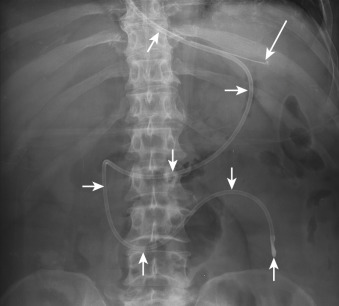
Coiling within the pharynx or esophagus may occur even if the tip of the tube is in the appropriate position; this may sometimes induce vomiting and subsequent aspiration ( Figure 22-4 ). Vomiting and aspiration may also occur if the tip is situated above the gastroesophageal junction. With tracheobronchial placement, a tube follows the course of the trachea and bronchi; lung perforation and entry into the pleural space can occasionally occur, leading to intrabronchial or intrapleural infusion of feedings, pneumonia, lung abscess, empyema, hydropneumothorax, or pneumothorax ( Figure 22-5 ). Esophageal perforation is a rare but serious complication. However, extraesophageal tube placement is difficult to detect on a frontal radiograph unless other views or water-soluble contrast agent injection are performed, which may show a tube that does not follow the expected course of the esophagus, a widened mediastinum, pneumomediastinum, a unilateral pleural effusion, or contrast agent leak from the esophagus into other thoracic compartments.
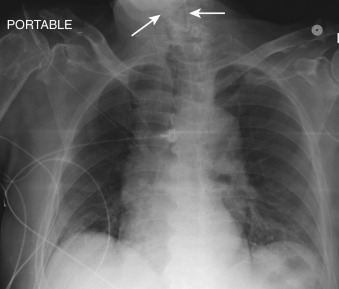
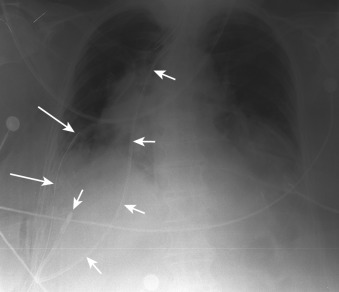
One should have a thoracostomy tube set ready at the patient's bedside before removing the tube, in case the tube has entered the pleural space and a pneumothorax suddenly develops when the tube is removed.
A thoracostomy tube is usually placed for drainage of air (pneumothorax), particularly when persistent (i.e., with a bronchopleural fistula), large, increasing, or symptomatic (i.e., under tension). Thoracostomy tubes are also placed for drainage of fluid (pleural effusion), blood (hemothorax), chylous fluid (chylothorax), or pus (empyema) from the pleural space. They are also sometimes placed for drainage of a lung abscess.
A thoracostomy tube usually appears as a faintly radiopaque tube with a thin, densely radiopaque line along the entire length of the tube. Similar to an NGT/OGT, the thin, densely radiopaque line is interrupted near the tip of the thoracostomy, representing the site of a side hole. Thoracostomy tubes should curve gently within the thorax ( Figure 22-6 ), because kinks may prevent appropriate drainage. For drainage of a pneumothorax, the tube should be positioned near the lung apex at the anterior axillary line and directed anterosuperiorly, whereas for drainage of a pleural effusion, the tube may be positioned at the midaxillary line and directed posteroinferiorly through the sixth through eighth intercostal spaces. In either case, the side hole should always be located medial to the ribs within the pleural space and not within the chest wall. Computed tomography (CT) is indicated when a thoracostomy tube does not drain air or fluid properly, and the chest radiograph is noncontributory.
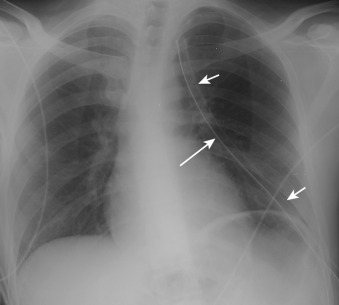
Persistent pneumothorax and extensive subcutaneous emphysema may occur if side holes are located external to the rib cage and pleural space ( Figure 22-7 ). Lung laceration ( Figure 22-8 ) with bronchopleural fistula may also occur with a persistent pneumothorax, pneumomediastinum, or extensive subcutaneous emphysema and is more commonly seen with preexisting lung disease or pleural adhesions. Laceration or injury of an intercostal artery, phrenic nerve, thoracic duct, diaphragm, liver, spleen, stomach, mediastinum, heart, breast, or pectoralis muscle may also occur. Placement within an interlobar fissure is common, which may cause poor tube function, and is best seen on CT. Soft tissue or pleural infection may occur adjacent to the tube insertion site. Unilateral reexpansion pulmonary edema may be seen with rapid pleural decompression, and rapid development of an infiltrate at the tip or side holes may be due to pulmonary infarction from suction of lung tissue. High insertion in the posterior chest wall may lead to Horner syndrome, and recurrence of a pleural collection, pleurocutaneous fistula, or retention of a tube fragment are potential complications after tube removal.
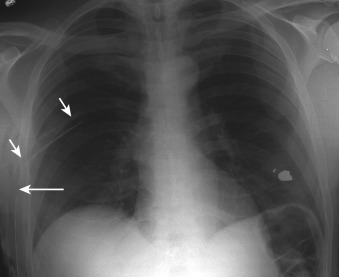
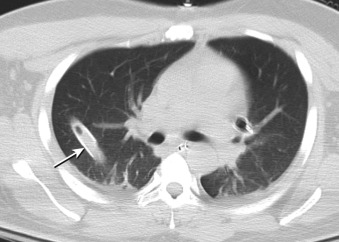
Become a Clinical Tree membership for Full access and enjoy Unlimited articles
If you are a member. Log in here